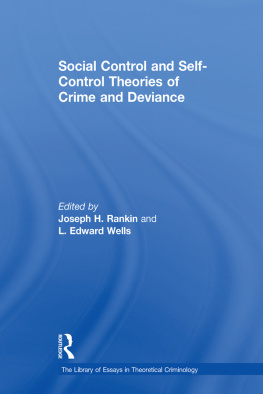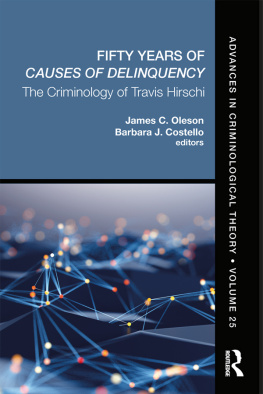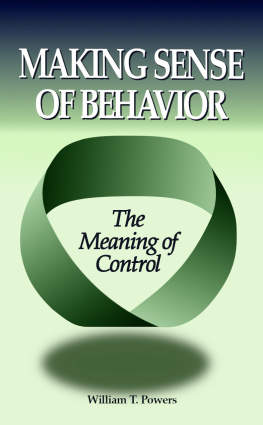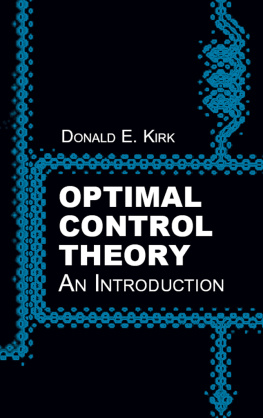Control Theories of Crime and Delinquency
EDITORS
Freda Adler
Rutgers University
William S. Laufer
University of Pennsylvania
EDITORIAL BOARD
Advances in Criminological Theory
Robert Agnew
Emory University
Terrie E. Moffit
University of Wisconsin-Madison
Ko-Lin Chin
Rutgers University
Gerhard O. W. Mueller
Rutgers University
Albert K. Cohen
University of Connecticut
Joan Petersillia
University of Califomia-Irvine
Francis T. Cullen
University of Cincinnati
Robert J. Sampson
University of Chicago
Simon Dinitz
Ohio State University
Kip Schlegel
Indiana University
Delbert Elliott
University of Colorado
Lawrence Sherman
University of Pennsylvania
David Farrington
Cambridge University
David Weisburd
Herbrew University
James O. Finckenauer
Rutgers University
Elmar Weitekamp
University of Tubingen
John Laub
University of Maryland
William Julius Wilson
Harvard University
Joan McCord
Temple University
Advances in Criminological Theory
Volume 12
Control Theories of Crime and Delinquency
Chester L. Britt
Michael R. Gottfredson
editors
First published 2003 by Transaction Publishers
Published 2017 by Routledge
2 Park Square, Milton Park, Abingdon, Oxon OX14 4RN
711 Third Avenue, New York, NY 10017, USA
Routledge is an imprint ofthe Taylor & Francis Group, an informa business
Copyright 2003 by Taylor & Francis
All rights reserved. No part of this book may be reprinted or reproduced or utilised in any form or by any electronic, mechanical, or other means, now known or hereafter invented, including photocopying and recording, or in any information storage or retrieval system, without permission in writing from the publishers.
Notice:
Product or corporate names may be trademarks or registered trademarks, and are used only for identification and explanation without intent to infringe.
Library of Congress Catalog Number: 2003040220
ISSN: 0894-2366
Library of Congress Cataloging-in-Publication Data
Control theories of crime and delinquency / Chester L. Britt and
Michael R. Gottfredson, editors.
p. cm. (Advances in criminological theory; v. 12)
Includes bibliographical references (p. ) and index.
ISBN 0-7658-0180-9 (cloth: alk. paper)
1. Criminology. I. Britt, Chester L. II. Gottfredson, Michael R. III. Series.
HV6018.C66 2003
364-dc21
2003040220
ISBN 13: 978-0-7658-0180-7 (hbk)
Contents
Chester L. Britt and Michael R. Gottfredson
Michael R. Gottfredson and Travis Hirschi
Matt DeLisi
Todd A. Armstrong
Robert Agnew
Barbara J. Costello and Helen J. Mederer
Augustine Brannigan and Kelly H. Hardwick
Kevin M. Thompson and Leana Allen Bouffard
Travis Hirschi and Michael R. Gottfredson
Chester L. Britt
Alexander T. Vazsonyi
Marianne Junger and Maja Dekovi
Henriette Haas and Martin Killias
Correlations between the Social Control, Delinquent Peers, and Delinquency Measures
General and Serious Delinquency Regressed on the Social Control and Delinquent Peer Measure (Standardized effects shown, with unstandardized effects in parentheses)
General and Serious Delinquency Regressed on the Social Control, Delinquent Peer, and Interaction Measures, with the Interactions Added One at a Time
General and Serious Delinquency Regressed on the Social Control, Delinquent Peer, and Interaction Measures, with the Interactions Added Together
Descriptive Statistics of Demographic Variables, Low Self-Control, and Deviance by Country
Model Fit for Individual Groups by Sex and by Country
Relationships between Risk-Taking Behaviors
Incidence of Different Types of Offenses among the 21,314 Recruits during the Twelve Months Preceding Recruit Training
Serial and Serious Offenders among the 21,314 Recruits in a Twelve-Month Period
Incidence of Different Offenses Committed by Serial and Serious Offenders over a Twelve-Month Period
Overlapping of Different Types of Specializations among Different Types of Serial and Severe Offenders over a Twelve-Month Period
Listing of the Independent Variables Introduced into the Logistic Regression Algorithm
Resulting Model for Bodily Injury
Model Fitting Information for Table 12.6 on the Logistic Regression of Bodily Injury
Resulting Logistic Regression Model for Forcible Rape
Model Fitting Information for Table 12.8 on the Logistic Regression of Rape
Scatter Plot of Low Self-Control and Total Deviance by Country (Males)
Scatter Plot of Low Self-Control and Total Deviance by Country (Females)
Chester L. Britt and Michael R. Gottfredson
By most measures, control theories continue to be among the most popular explanations for crime and delinquency. Polls of criminologists place control theories at the top of the list of theories thought to be most viable (Ellis and Walsh, 1999). Citation studies indicate that control theory authors are among the most frequently cited scholars in the field (Cohn, Farrington, and Wright, 1998). Textbooks designed for undergraduates routinely include sections dedicated to control theory explanations. Today, scholarly debates about the causes of crime and delinquency are often debates within control theory rather than debates between control theories and other explanations, and long-time oppositional theories seek to incorporate control theory into their explanations more frequently than they seek to deny its validity.
Perhaps the principal source of this popularity is that control theory accommodates both of the great traditions in criminology: the positivist and the classical schools. The positivistic side of control theory focuses on the causes of crime being determined by differences among people in their dispositions to engage in crime and delinquency. Thus, control theories welcome efforts to measure crime and delinquency more effectively, to assign people different probabilities of engaging in criminal behavior according to their individual and social characteristics, and to study such differences at various points across the life-course. As such, control theories are appealing to social and behavioral scientists from a wide range of disciplines who study empirical differences in the causes of behavior. The generally accepted findings that most problem behaviors of interest to sociologists and psychologists are highly related among subjects and, of course, have common antecedents and consequences for life events, are findings easily accommodated by control theories. Whether or not the terms favored by various control theorists are employed in this work, the combination of a vast body of empirical research focused on identifying early childhood experiences as causing multiple problem behaviors, the distribution of these behaviors by age, and the persistent effects of parents and peers in the causal chain are the








